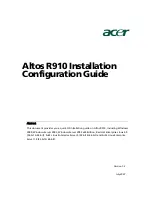
Symptom
Action
The system stopped and a code is displayed on the
operator panel.
Go to the “Quick Entry MAP” on page 63.
The rack identify LED does not operate properly.
Go to the “Entry MAP” on page 61.
The system stops with a prompt to enter a password.
Enter the password. You cannot continue until a correct
password has been entered. When you have entered a
valid password, go to the beginning of this table and wait
for one of the other conditions to occur.
The diagnostic operating instructions are displayed.
Go to
″
MAP 0020: Problem Determination Procedure
″
in
the
RS/6000
Eserver
pSeries Diagnostic Information for
Multiple Bus Systems
.
Symptom:
The system login prompt is displayed.
Action:
If you are loading the diagnostics from a CD-ROM, you may not have pressed the correct key or you may
not have pressed the key soon enough when you were trying to indicate a service mode IPL of the diagnostic
programs. If this is the case, start again at the beginning of this step.
Note:
Perform the system shutdown procedure before turning off the system.
If you are sure you pressed the correct key in a timely manner, go to “Step 1020-2” on page 72.
If you are loading diagnostics from a NIM server, check for the following:
v
The bootlist on the client may be incorrect.
v
Cstate on the NIM server may be incorrect.
v
There may be network problems preventing you from connecting to the NIM server.
Verify the settings and the status of the network. If you continue to have problems refer to “Boot Problems/Concerns”
on page 204 and follow the steps for network boot problems.
The system does not respond when the password is
entered.
Go to “Step 1020-2” on page 72.
Symptom:
The system stopped. A POST indicator is displayed on the system console and an eight-digit error code
is not displayed.
Action:
If the POST indicator represents:
1. Memory, go to “MAP 1240: Memory Problem Resolution” on page 73.
2. Keyboard
a. Replace the keyboard.
b. Replace the CEC backplane, location U0.1-P1. (See notes on page 61).
c. Go to “MAP 1548: Processor Subsystem Problem Isolation” on page 139.
3. Network, go to “MAP 1548: Processor Subsystem Problem Isolation” on page 139.
4. SCSI, go to “MAP 1548: Processor Subsystem Problem Isolation” on page 139.
5. Speaker
a. Replace the operator panel, location U0.1-L1. Refer to “Operator Panel” on page 484.
b. Replace the CEC backplane, location: U0.1-P1. (See notes on page 61).
c. Go to “MAP 1548: Processor Subsystem Problem Isolation” on page 139.
Chapter 3. Maintenance Analysis Procedures (MAPs)
71
Summary of Contents for @Server pSeries 630 6C4
Page 1: ...pSeries 630 Model 6C4 and Model 6E4 Service Guide SA38 0604 03 ERserver...
Page 2: ......
Page 3: ...pSeries 630 Model 6C4 and Model 6E4 Service Guide SA38 0604 03 ERserver...
Page 16: ...xiv Eserver pSeries 630 Model 6C4 and Model 6E4 Service Guide...
Page 18: ...xvi Eserver pSeries 630 Model 6C4 and Model 6E4 Service Guide...
Page 382: ...362 Eserver pSeries 630 Model 6C4 and Model 6E4 Service Guide...
Page 440: ...420 Eserver pSeries 630 Model 6C4 and Model 6E4 Service Guide...
Page 538: ...System Parts continued 518 Eserver pSeries 630 Model 6C4 and Model 6E4 Service Guide...
Page 541: ...Chapter 10 Parts Information 521...
Page 562: ...542 Eserver pSeries 630 Model 6C4 and Model 6E4 Service Guide...
Page 568: ...548 Eserver pSeries 630 Model 6C4 and Model 6E4 Service Guide...
Page 576: ...556 Eserver pSeries 630 Model 6C4 and Model 6E4 Service Guide...
Page 580: ...560 Eserver pSeries 630 Model 6C4 and Model 6E4 Service Guide...
Page 616: ...596 Eserver pSeries 630 Model 6C4 and Model 6E4 Service Guide...
Page 646: ...626 Eserver pSeries 630 Model 6C4 and Model 6E4 Service Guide...
Page 649: ......















































